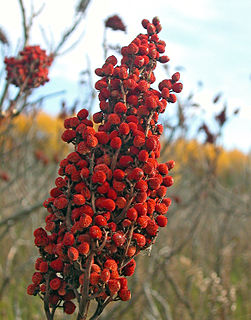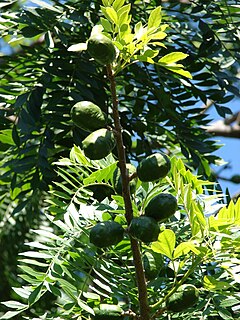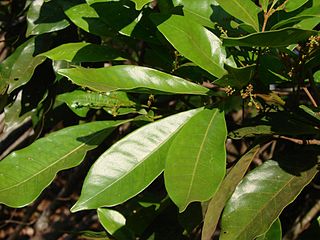
Sapindales is an order of flowering plants. Well-known members of Sapindales include citrus; maples, horse-chestnuts, lychees and rambutans; mangos and cashews; frankincense and myrrh; mahogany and neem.

Pistacia is a genus of flowering plants in the cashew family, Anacardiaceae. It contains 10 to 20 species that are native to Africa and Eurasia from the Canary Islands, all of Africa, and southern Europe, warm and semidesert areas across Asia, and North America from Mexico to warm and semidesert United States, such as Texas or California.

The Anacardiaceae, commonly known as the cashew family or sumac family, are a family of flowering plants, including about 83 genera with about 860 known species. Members of the Anacardiaceae bear fruits that are drupes and in some cases produce urushiol, an irritant. The Anacardiaceae include numerous genera, several of which are economically important, notably cashew, mango, poison ivy, sumac, smoke tree, marula, yellow mombin, Peruvian pepper and cuachalalate. The genus Pistacia is now included, but was previously placed in its own family, the Pistaciaceae.

Sumac or, also spelled sumach,sumak,soumak, and sumaq, is any one of about 35 species of flowering plants in the genus Rhus and related genera, in the family Anacardiaceae. Sumac grows in subtropical and temperate regions throughout the world, especially in East Asia, Africa, and North America.

The Burseraceae are a moderate-sized family of 17-19 genera and about 540 species of flowering plants. The actual numbers differ according to the time period in which a given source is written describing this family. The Burseraceae are also known as the torchwood family, the frankincense and myrrh family, or simply the incense tree family. The family includes both trees and shrubs, and is native to tropical regions of Africa, Asia, and the Americas.

Schinus terebinthifolia is a species of flowering plant in the cashew family, Anacardiaceae, that is native to subtropical and tropical South America. It is found in these states of Brazil: Alagoas, Bahia, Espírito Santo, Mato Grosso do Sul, Minas Gerais, Pernambuco, Paraná, Rio de Janeiro, Rio Grande do Norte, Rio Grande do Sul, Santa Catarina, São Paulo, and Sergipe. Common names include Brazilian peppertree, aroeira, rose pepper, broadleaved pepper tree, wilelaiki, Christmasberry tree and Florida holly. The species name has been very commonly misspelled as "terebinthifolius", due to considerable historic confusion as to the correct gender of the genus name; as of 2015 this has been resolved with the determination that the correct gender of Schinus is feminine, and adjectival names within the genus must be spelled accordingly.

Spondias is a genus of flowering plants in the cashew family, Anacardiaceae. The genus consists of 17 described species, 7 of which are native to the Neotropics and about 10 are native to tropical Asia. They are commonly named hog plums, Spanish plums, libas in Bikol and in some cases golden apples for their brightly colored fruit which resemble an apple or small plum at a casual glance. They are only distantly related to apple and plum trees, however. A more unequivocal common name is mombins.

Metopium toxiferum, the poisonwood, Florida poisontree, or hog gum, is a species of flowering tree in the cashew or sumac family, Anacardiaceae, that is native to the American neotropics. It produces the irritant urushiol much like its close relatives poison sumac and poison oak. It is related to black poisonwood.
Antrocaryon micraster is a species of flowering plant in the cashew family, Anacardiaceae. It is native to tropical Africa, where it occurs in Cameroon, the Democratic Republic of the Congo, Ivory Coast, Ghana, Nigeria, Sierra Leone, and Uganda. It grows in gaps in the forest canopy. It is harvested for its wood.
Mangifera austro-indica is a species of plant in the family Anacardiaceae. It is native to Karnataka and Tamil Nadu in India.

Mangifera lalijiwa is a species of plant in the Anacardiaceae family. It is native to Java and the Lesser Sunda Islands. It is threatened by habitat loss.

Mangifera odorata is a species of plant in the family Anacardiaceae. It is native to Guam, the Philippines, Thailand and Vietnam and cultivated in Indonesia, Malaysia and Singapore.

Bouea macrophylla, commonly known as gandaria or plum mango or mango plum in English, is a species of flowering plant native to Southeast Asia. The tree belongs to the Anacardiaceae family which also includes mango and cashew.

Mangifera indica, commonly known as mango, is a species of flowering plant in the sumac and poison ivy family Anacardiaceae. It is native to the Indian subcontinent where it is indigenous. Hundreds of cultivated varieties have been introduced to other warm regions of the world. It is a large fruit-tree, capable of growing to a height and crown width of about 30 metres (100 ft) and trunk circumference of more than 3.7 metres (12 ft).

Tapirira guianensis is a species of plant in the family Anacardiaceae. It is native to Cerrado and Atlantic Forest (ecoregions) vegetation in Brazil.
Tapirira marchandii is a species of plant in the family Anacardiaceae family. It is native to Cerrado vegetation in Brazil.
Tapirira obtusa is a species of plant in the family Anacardiaceae. It is native to Cerrado vegetation in Brazil.

Rhus virens is a species of flowering plant in the mango family, Anacardiaceae, that is native to Arizona, southern New Mexico, and Texas in the United States as well as northern and central Mexico as far south as Oaxaca. It is commonly known as the evergreen sumac or tobacco sumac.

Schinus polygama, the Hardee peppertree or Chilean pepper tree, is a species of plant in the Anacardiaceae family which is native to Argentina and Chile and naturalized in California.

Comocladia dodonaea, with common names poison ash, and Christmas bush, is a species of tree in the cashew family, Anacardiaceae. It is native to Caribbean islands.















